New clues to how synapses in the brain are programmed
July 25, 2014

Cerebellar granule cells, parallel fibers, and flattened dendritic trees of Purkinje cells (credit: Wikimedia Commons)
Washington University School of Medicine researchers have identified a group of proteins that program synapses in the brain, controlling neural development and learning, with implications for conditions such as autism.
In a study of the cerebellum (which plays a central role in controlling the coordination of movement and is essential for “procedural motor learning”) of mice, published in the journal Neuron, they found that a complex of proteins known as NuRD (nucleosome remodeling and deacetylase) plays an important role in development of the cerebellum.
When the researchers blocked the NuRD complex, cells in the cerebellum called granule cells (the most numerous neurons in the brain) failed to form connections with Purkinje neurons. These circuits are important for the cerebellum’s control of movement coordination and learning.
Programming gene activity in synapses
They found that NuRD exerts influence at the epigenetic level, which means factors other than DNA that affect gene activity. For example, NuRD affects the configurations of molecules that store DNA and that can open and close the coils of DNA like an accordion, making genes less or more accessible. Changing the accessibility of genes changes their activity levels. For instance, cells can’t frequently make proteins from genes in a tightly packed coil of DNA.
NuRD also alters tags (peptide molecular sequences) on the proteins that store DNA, decreasing the chances that the gene will be used. Among the genes controlled by NuRD are two that control the activity of other genes involved in the wiring of the cerebellum.
“This tells us that the NuRD complex is very influential — not only does it affect the activity of genes directly, it also controls other regulators of multiple genes,” said senior author Azad Bonni, MD, PhD, the Edison Professor of Neurobiology and head of the Department of Anatomy and Neurobiology at the School of Medicine.
“The cerebellum also regulates mental functions,” Bonni said. “So, impairment of the wiring of nerve cells in the cerebellum may contribute to movement disorders as well as cognitive problems including autism spectrum disorders.”
Funding from the National Institutes of Health, the Mathers Foundation, and the Japan Society for the Promotion of Science supported this research.
Yes, nurd brain jokes will be tolerated in comments. — Editor
Abstract of Neuron paper
- The NuRD chromatin remodeling complex drives synapse differentiation in the brain
- NuRD complex represses a program of genes in neurons as they mature in the brain
- NuRD complex decommissions the promoters of repressed genes in neurons
- In vivo screen uncovers specific NuRD targets that control synapse differentiation
Precise control of gene expression plays fundamental roles in brain development, but the roles of chromatin regulators in neuronal connectivity have remained poorly understood. We report that depletion of the NuRD complex by in vivo RNAi and conditional knockout of the core NuRD subunit Chd4 profoundly impairs the establishment of granule neuron parallel fiber/Purkinje cell synapses in the rodent cerebellar cortex in vivo. By interfacing genome-wide sequencing of transcripts and ChIP-seq analyses, we uncover a network of repressed genes and distinct histone modifications at target gene promoters that are developmentally regulated by the NuRD complex in the cerebellum in vivo. Finally, in a targeted in vivo RNAi screen of NuRD target genes, we identify a program of NuRD-repressed genes that operate as critical regulators of presynaptic differentiation in the cerebellar cortex. Our findings define NuRD-dependent promoter decommissioning as a developmentally regulated programming mechanism that drives synaptic connectivity in the mammalian brain.